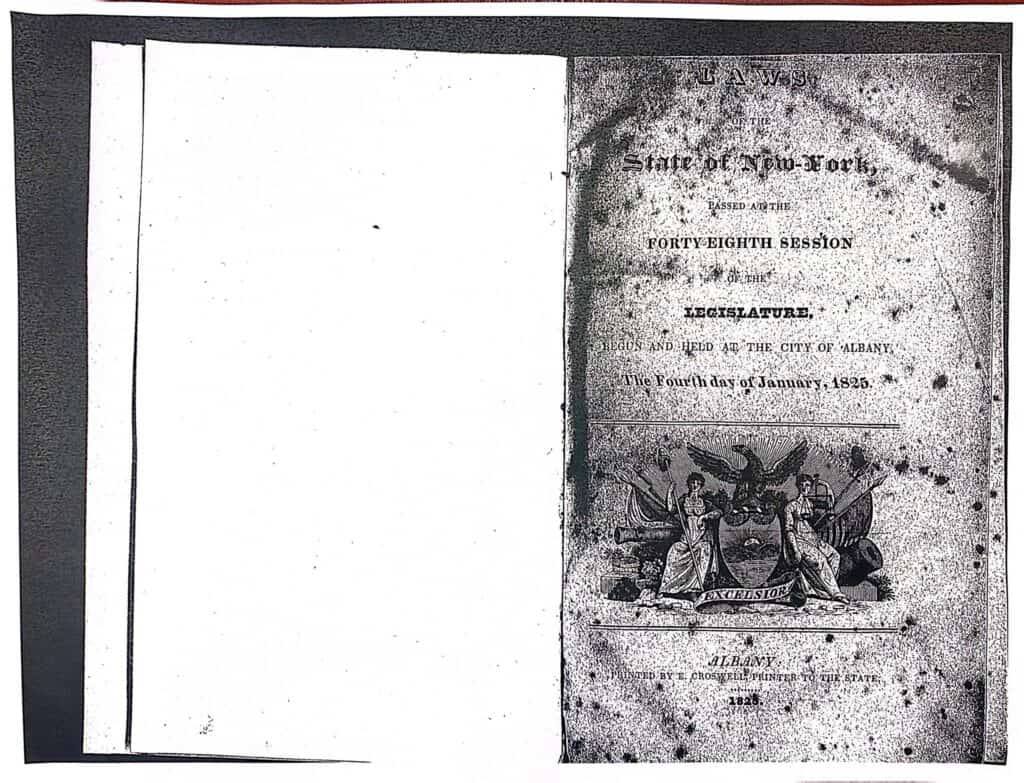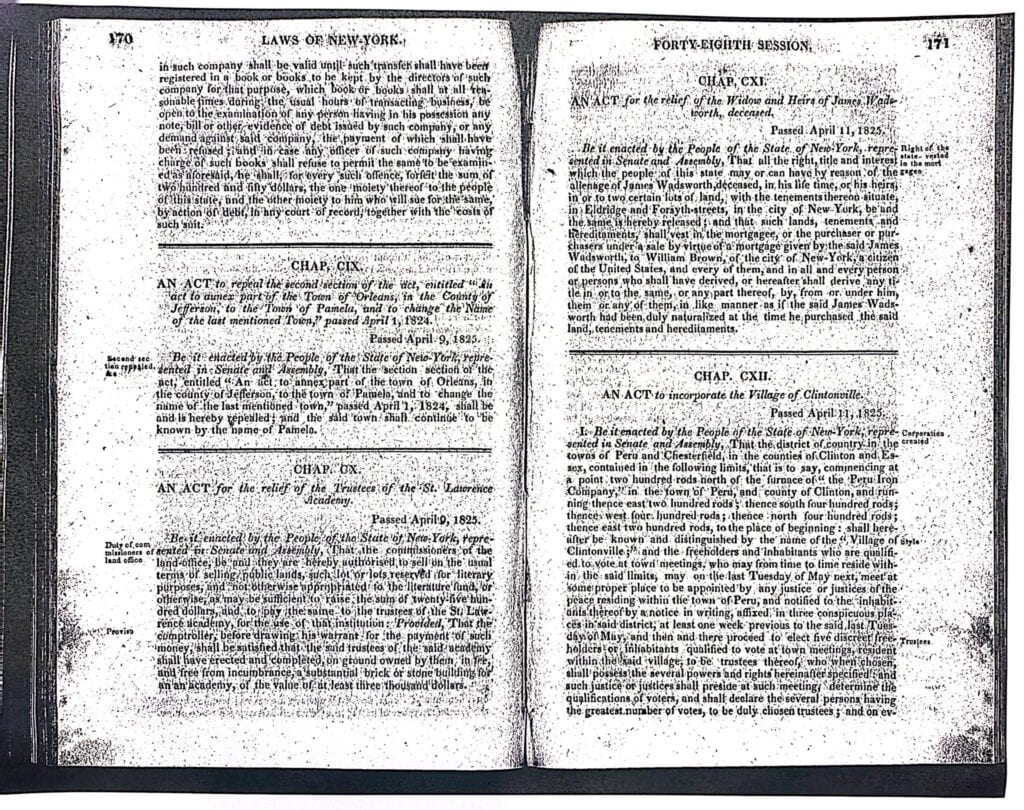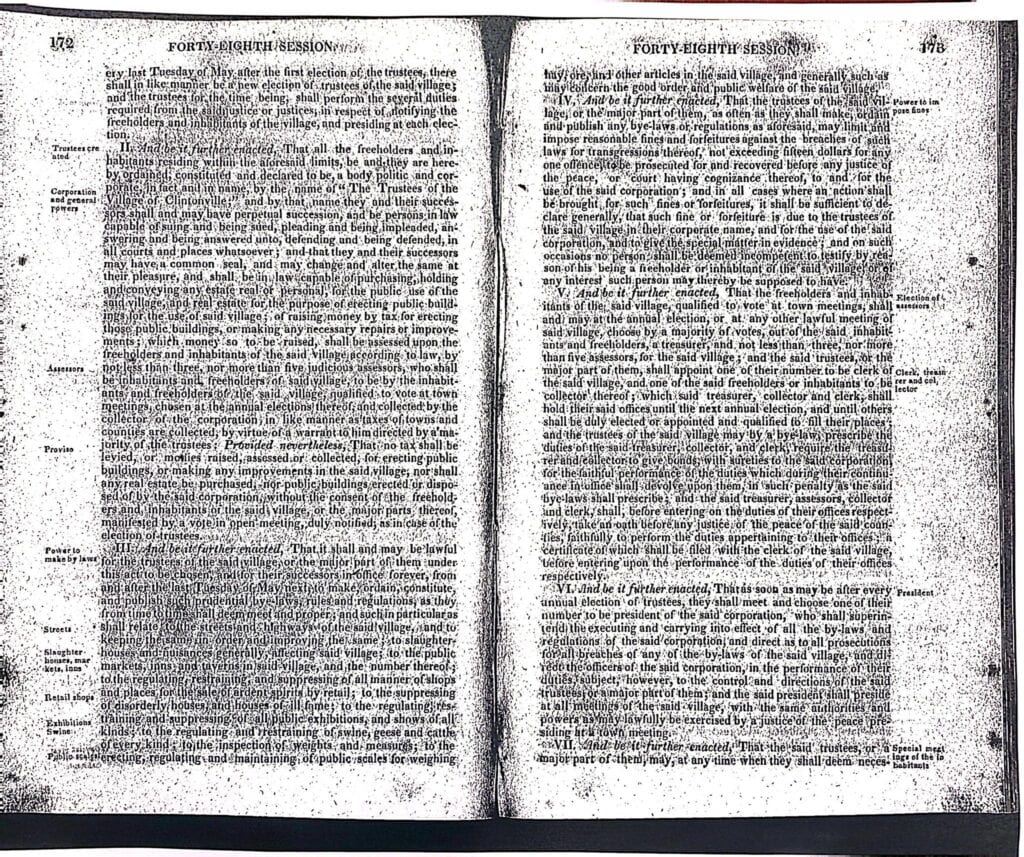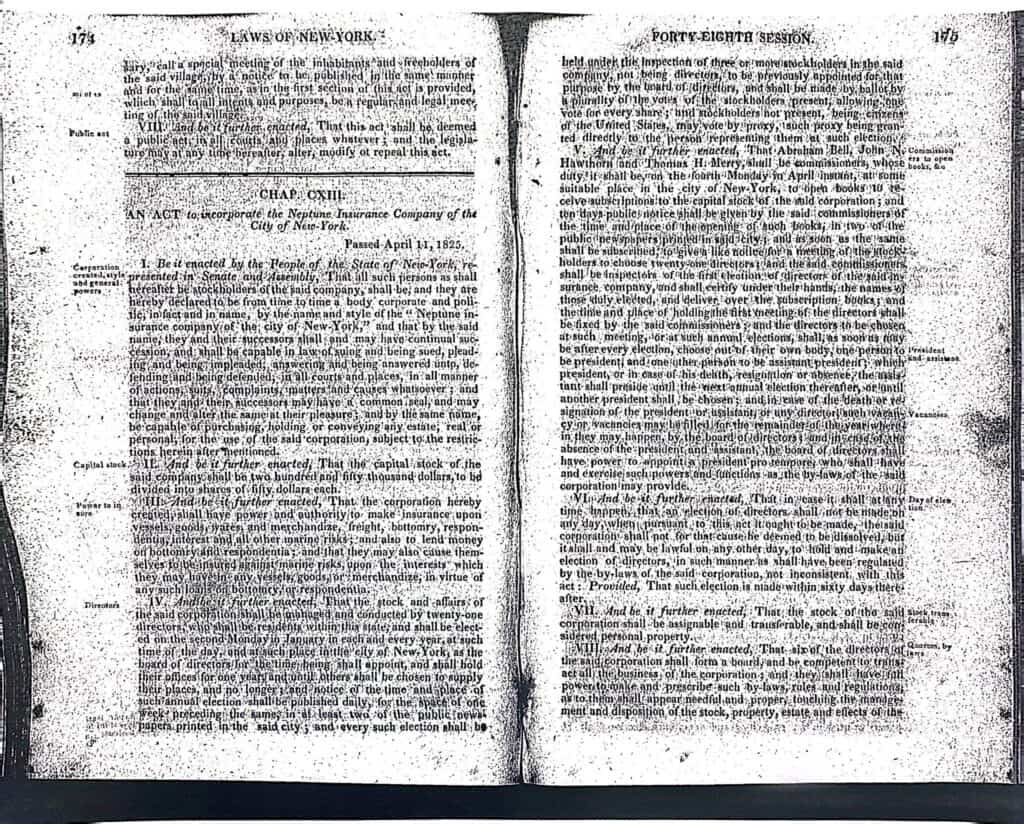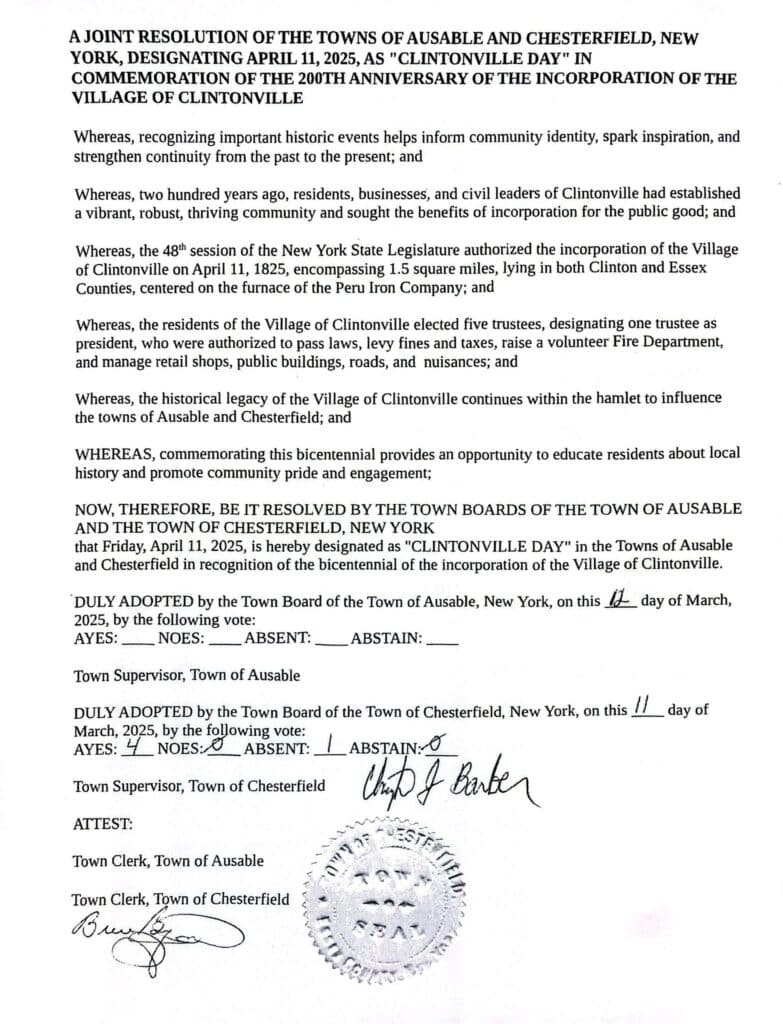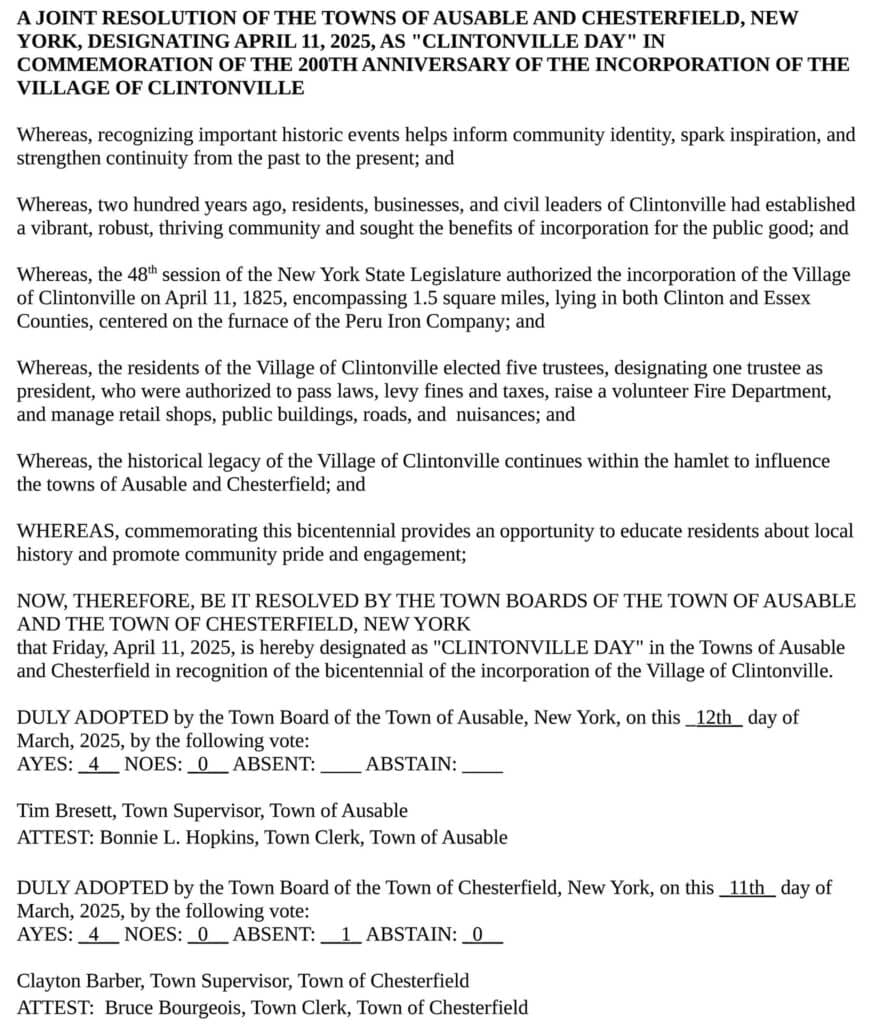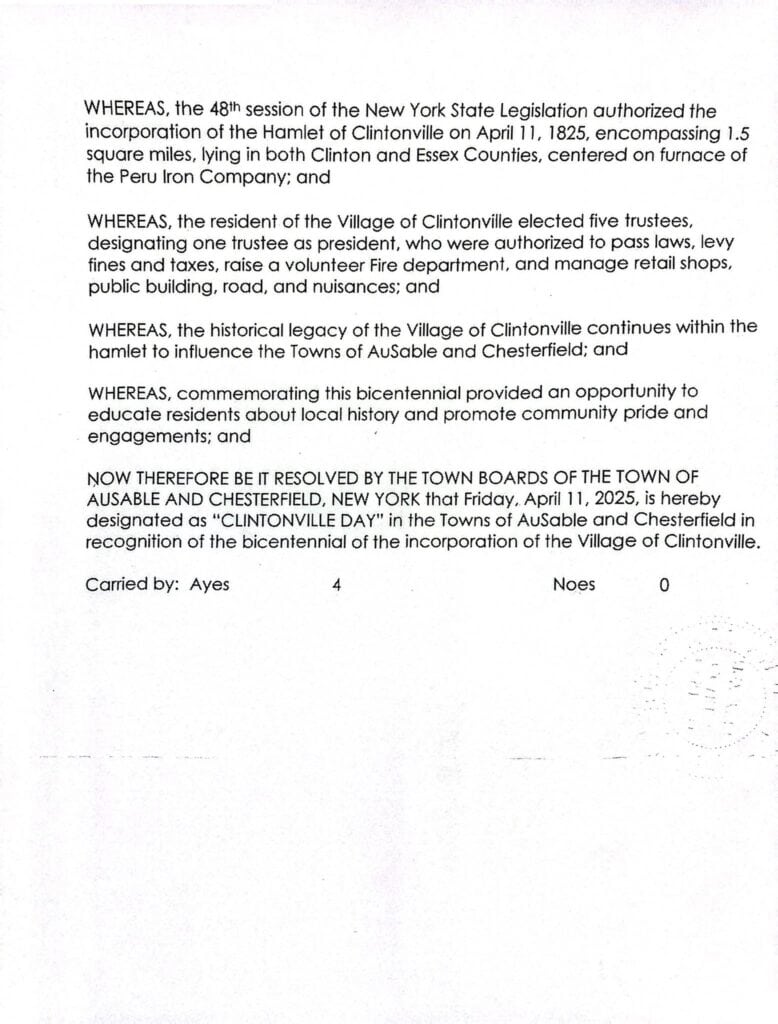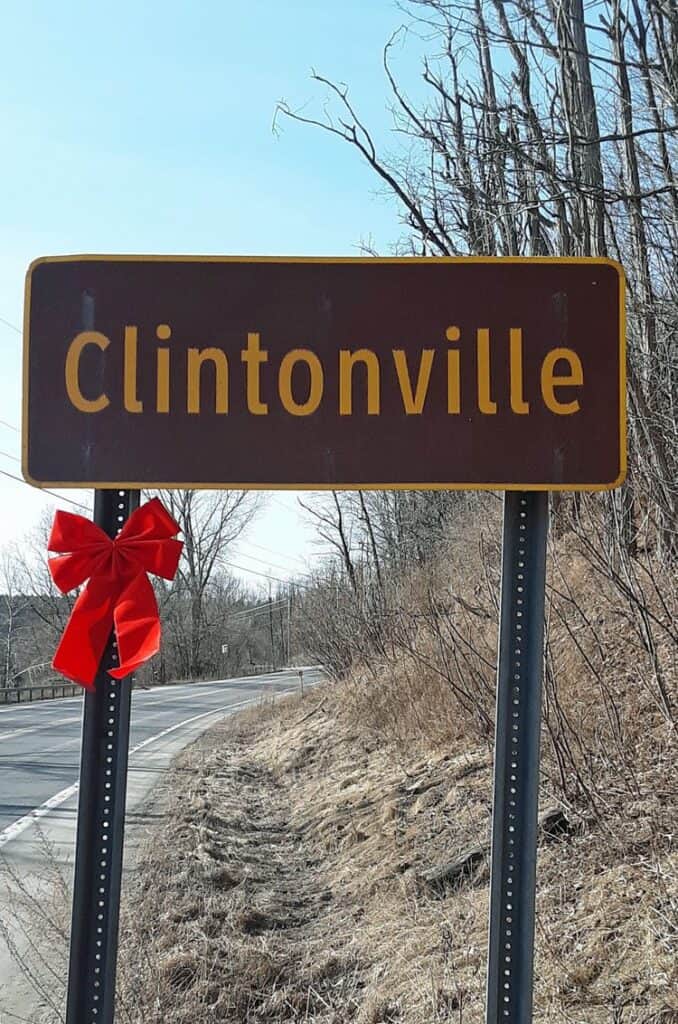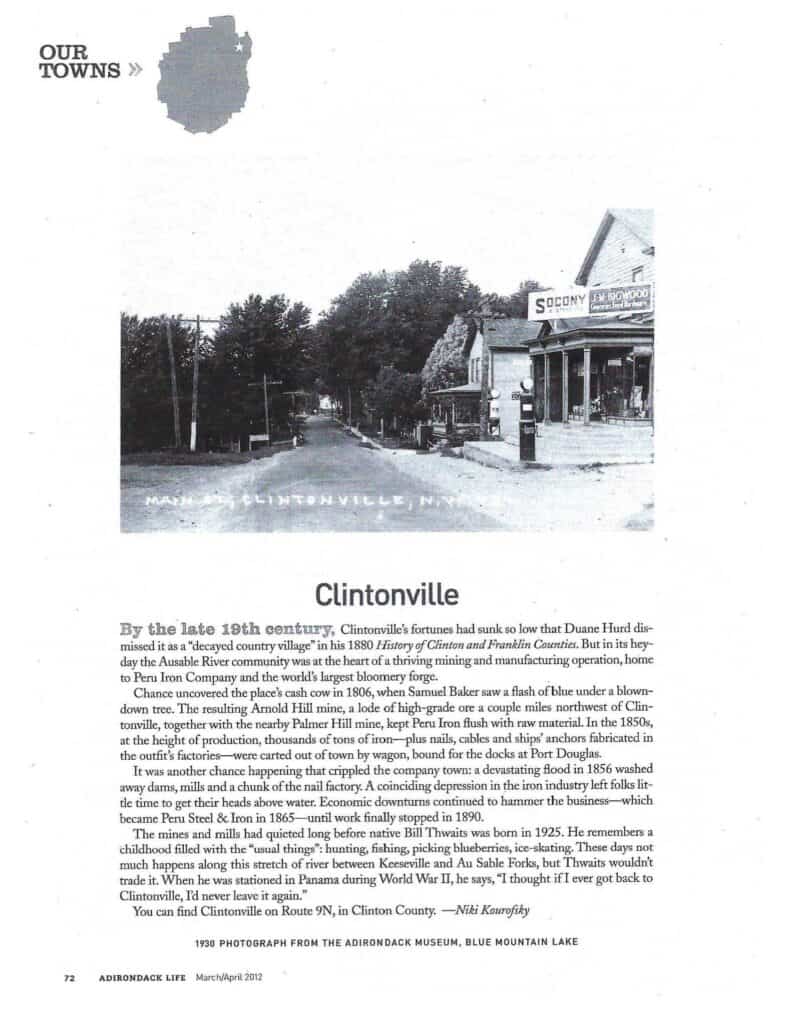Clintonville is one of our smaller communities in population, but it is big in other ways! Many notable people proudly call it their hometown. Do not judge a place by its size as Clintonville is big enough to have its own ZIP Code! Clintonville’s history is vast.
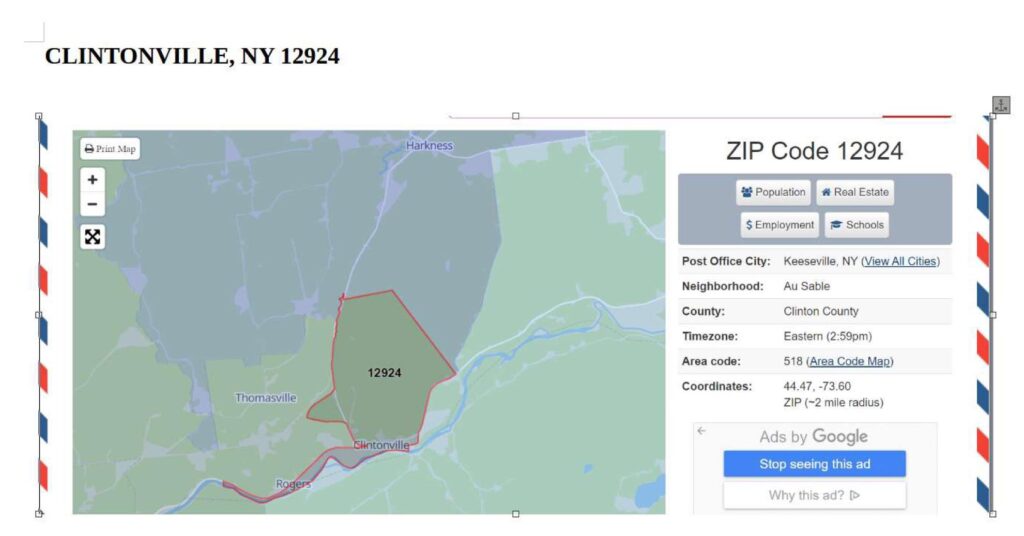
Each day during the week of April 7th – April 11th, 2025, we spotlighted Clintonville and its unique story. We took a close-up look at its industrial origins, religious organizations, military service, personal memories, and early civil structure.
Join us in exploring a small hamlet with over 200 years of community. Please share this post widely with your friends and help Clintonville‘s story get 200 views in recognition of its bicentennial this week.
It was Clintonville week at Anderson Falls Heritage Society!
Day 1 – IRON INDUSTRY

Every real estate agent’s mantra is “Location, Location, Location!” and Clintonville certainly exemplifies this. Its location hit the trifecta of resources for robust industry: high-grade iron ore in the mountains, extensive forests of timber, and water power.
The Peru Iron and Steel Company mined ore from the Arnold Hill, Palmer Hill, and Winter mines to keep the sixteen fire bloomery forge operating nearly round the clock. From 1865-1882 there was at least 228,443 tons of ore mined, eclipsing similar operators of the era elsewhere. Timber was cut to make charcoal on site for fuel. Workers willing and able to perform the strenuous tasks flocked to Clintonville and nearby New Sweden. The industry defined the booming community with its employees, their families, and related support services such as stores, hotel, school, and churches. Iron operations ceased in the 1890s.
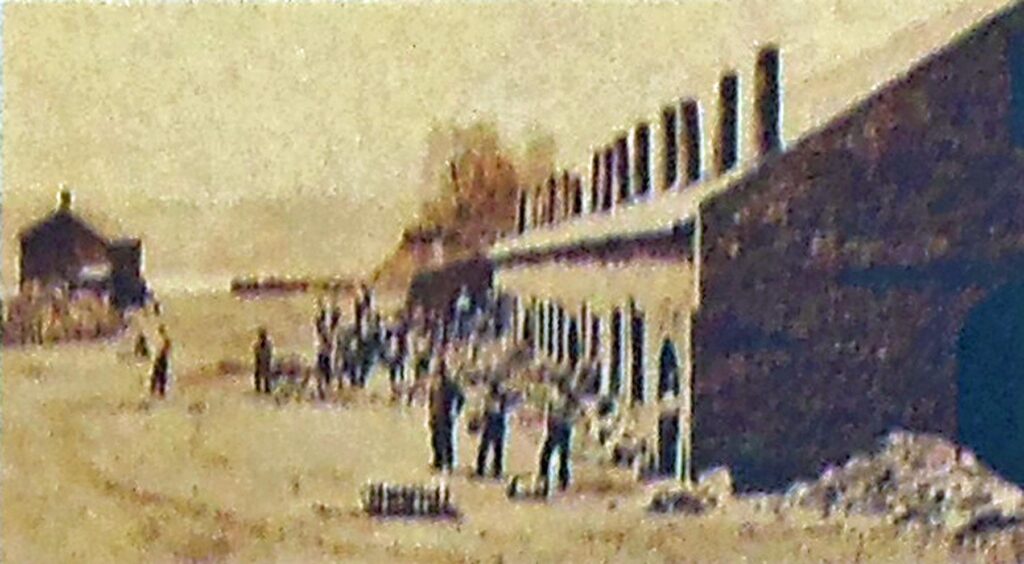
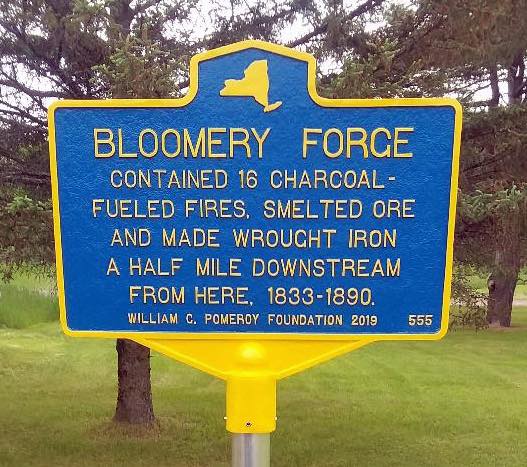
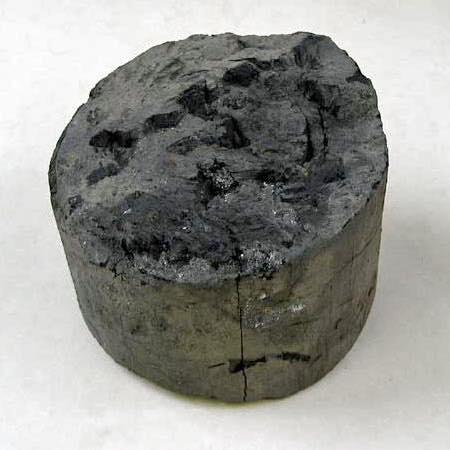
Anderson Falls Heritage Society is grateful to Dr. Gordon C. Pollard, SUNY Distinguished Teaching Professor Emeritus of Anthropology, for his presentation sharing his expertise on Clintonville’s iron industry of the 1800s.
[images: 1876 Peru Iron & Steel Co. bloomery forge; Clintonville forge charcoal, courtesy NorthCountyPublicRadio.org; historic roadside markers–Clintonville]
Day 2 – Churches
Clintonville had two churches within sight of one another on Route 9N. Both were active centers of community life. For example, in November 1940, under the pastorate of Rev. Fr. Donnelly, St. Catherine’s Church was the site of the marriage of Lillian Mitchell and Raymond O’Connell on the 9th, the funeral of Laura (Besaw) Gravel on the 11th, and a chicken pie dinner fund-raiser sponsored by the ladies for the redecorating fund on the 26th. The Methodist men put on a turkey dinner on November 14th. A full month in Clintonville!
The church building constructed by the Peru Iron and Steel Company was originally a Presbyterian Church and later became St. Catherine’s Roman Catholic Church.
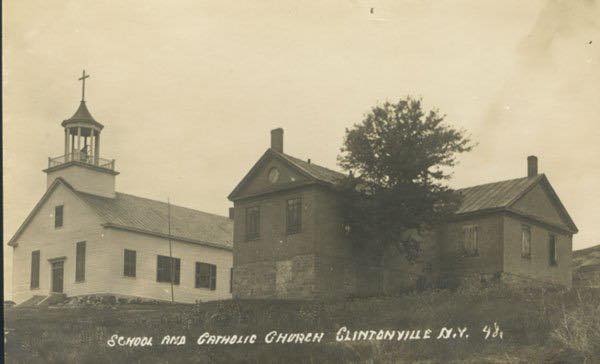
A published repertoire of vital events gives a sense of the size of the congregation recording 543 baptisms,168 marriages, and 266 burials over a hundred year period starting from July 1899. The building, now empty and privately owned, still stands atop the hill but no longer serves as a church. The public school building which formerly stood adjacent to it is gone. [St. Catherine’s Roman Catholic Church and brick school image, ca. 1910; Blue Mountain Lake Museum]
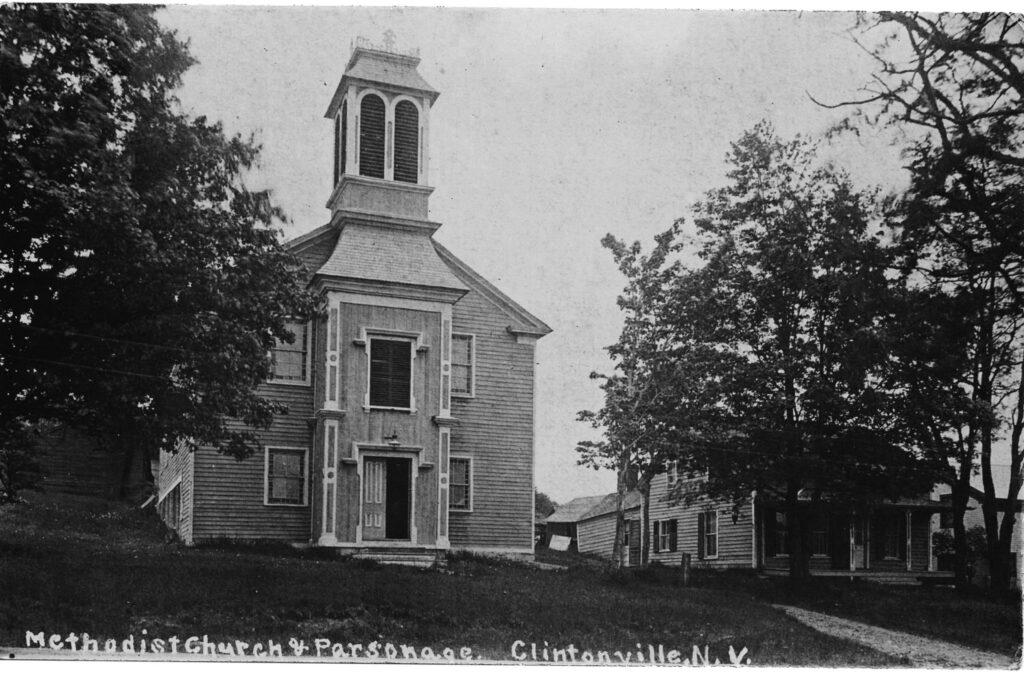
The Clintonville United Methodist Church was built in 1833. A rededication service was held on its 122 year anniversary.
It continues to hold regular worship services and fellowship events as well as operating a thrift store across the road.
The Old Clintonville Methodist Cemetery has about 792 burials and the Riverview Cemetery has 224 burials according to Findagrave.com.
Day 3 – Military Service
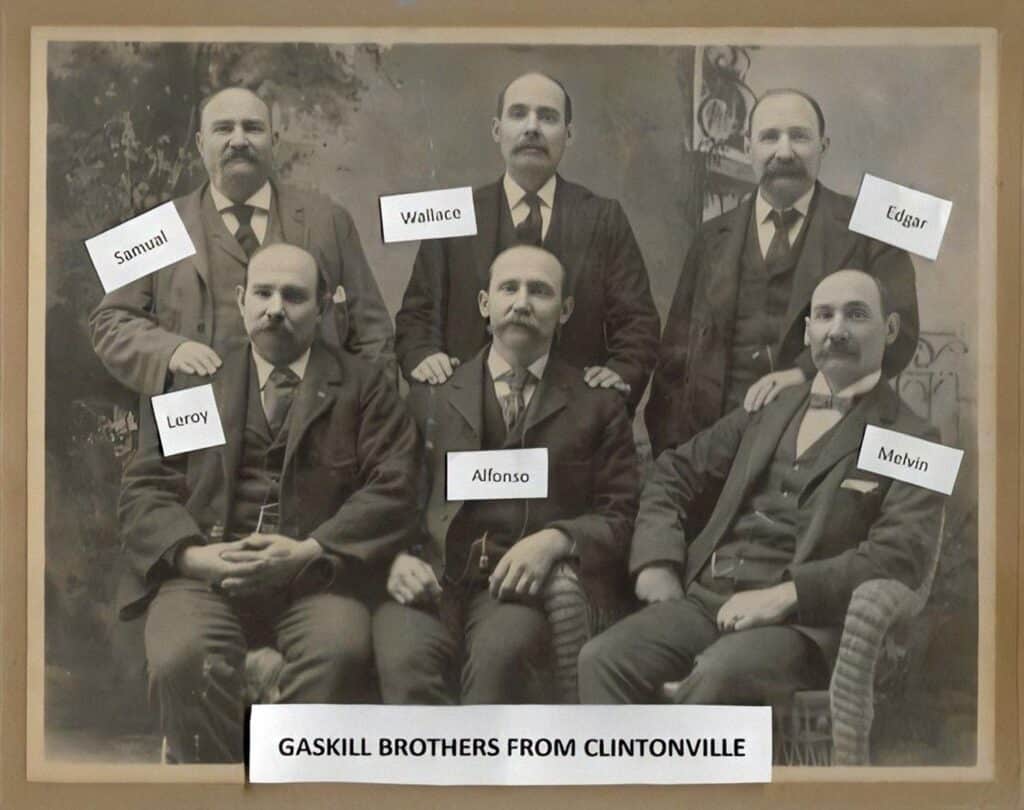
From Revolutionary War days to the present brave people have stepped up in military service to our country. One such example is the Gaskill family of Clintonville during the Civil War.
Jason B. Gaskill and his wife Lillis L. Duall had a large family including six sons. The four eldest sons, Samuel, Wallace, Alphonso, and Melvin, all enlisted in the Union Army. Samuel Gaskill began his service mustering in as a Corporal on June 6, 1861. He was taken prisoner by the Confederacy in April 1862 and paroled on the condition he not bear arms until exchanged. After returning home he was drafted in July 1863 and during this enlistment was wounded at the Battle of Olustee [Florida] in February 1864. During his hospitalization he wrote a touching poem reflecting on his fond memories of his youth in Clintonville. Samuel was discharged in May 1865, returned to Clintonville, and the following year he and his wife, Mary B. (Clodeau) Gaskill, welcomed their first child.
The Soldier’s Thought
Air the strcher..
In the state of South Carolina on an Isle called Hilton Head
A wounded unfortunate soldier lie on his bed
And as he lie thair musing his thoughts began to roam
A thinking of his Childhood and his native place at home
The first that Came to memory in his past and cheerful life
Is the one thats ever deare to him is his deare beloved wife
O Mary I can see the with all thy blooming pride
Just as you were a yeare ago before you ware my bride
We had wanderd through green medows and in the cooling shade
And often through the grave yard whare our poorkindred lay
And thair with mournful accent breath the sumer rays
Convercing of thair merits thay wrought in former days.
Then next that comes to memory it is my mother deare
Tthat rocked him in his cradle and wached his wild career
And when his boyhood trubles came rushing through his brain
Thair is no one like a mother to sooth and ease his pain
The next comes to memory and fills my hart with joy
It is his aged father that wached me from a boy
And many a long and dreery day he toiled thrug cold and rain
To give him an Education and save him from disdain
The next that comes to memory and brings back his boyhood days
It is brothers whome he loved so well and oft with them have strayd
Over mountains hills and forrest and by the crystle stream
I am thinkin of them dayley and in my nightley dreams
O well do I remember when we ware little boys
Tthe pleasure that we used to take a playing with our toys
Better do I remember when we begume to be men
Tthe day we left our pleasent home our country to defend
Tthe next that comes to memory and fills my hart with cheer
It is my loving Sisters for to me thay ware most deare
For of drery hours when trubled in my brain
Thair pleasent smiles have banished all my grief and pain
Oft have we set together beneath the old pine tree
Convercing of the days to come how hapy then ware we
And in sumer evening thay by my side did roamed
Down by the little river thats night my pleasant home
The next that comes to memory it is my native home
Whare I have spent my boyhood days and to manhood I have grown
Tthe store that’s to the front of it and to the rear a hill
Ware of Ive ben to plat at ball I think I see it still
And thair are the same old doorsteps that ware built thair long ago
The same old railings around them whare the lilock bushes grow
And thair the road to the right leads to the old saw mill
And the stone school house far byend it stands on Allen hill
Then thair is the road to the left that leads you on the plain
All times of night I have travled it through sunshine snow and rain
And thair ware meny a mary hart and. I hope thay are thair still
For meney a pleasant night so pass in the place call Clintonville (NY)
Thair I have met meney times them in age and in bloom
Sume times in the old white church more times in the ballroom
Whare meney a fare lady at the boys would steel a glance
And how often I have saw them blush when thay were asked to dance
But now those times are all pas the day has changed to night
For then most of the boys that ware thair then have gone away to fight
I hope that we may all return home to the ones that we love best dear
For I think the rebs must soon give up and end this wild career
Its my arm it pains me dreadfuley I scarse can hold my pen
Besides my friends it getting late the clock has just struck ten
So now Ile stop my writing and lay my pen by the sheet
And take a dose of morpheane and try to get sume sleep
Composed by Samuel J. Gaskill, Co A 47 Regt….36S V,
who was wounded at the battle of Olustee (Florida)
Feb the 20 1864 now in the hospttle at Hilton Head S C
Thanks to Mary Ellen Dengler, a descendant of Samuel Gaskill, for sharing the Gaskill brothers photo and poignant poem of Clintonville penned 161 years ago.
We invite our readers to name other Clintonville service members as we salute all who served past and present.
Day 4 – Clintonville Memory Lane
“The beauty of a hometown lies not only in its landscapes but in the hearts of its people.” – Unknown
Yesterday we shared Samuel Gaskill’s poetic Clintonville reflections that brought him comfort during his convalescence from battle wounds 161 years ago.
Another window into bygone days are the detailed reminiscences of L. Grant Palmer who wrote in 1921 about Clintonville and its residents. https://sites.rootsweb.com/~nyclinto/areahist/cltville.html
More tender memories are recalled about old-time family doctors. Dr. Clark was the first physician to practice in Clintonville and later practitioners included Drs. Bollen, Chase, Samuel Fitzgerald, Bassett, D’Avignon, and Mosier.
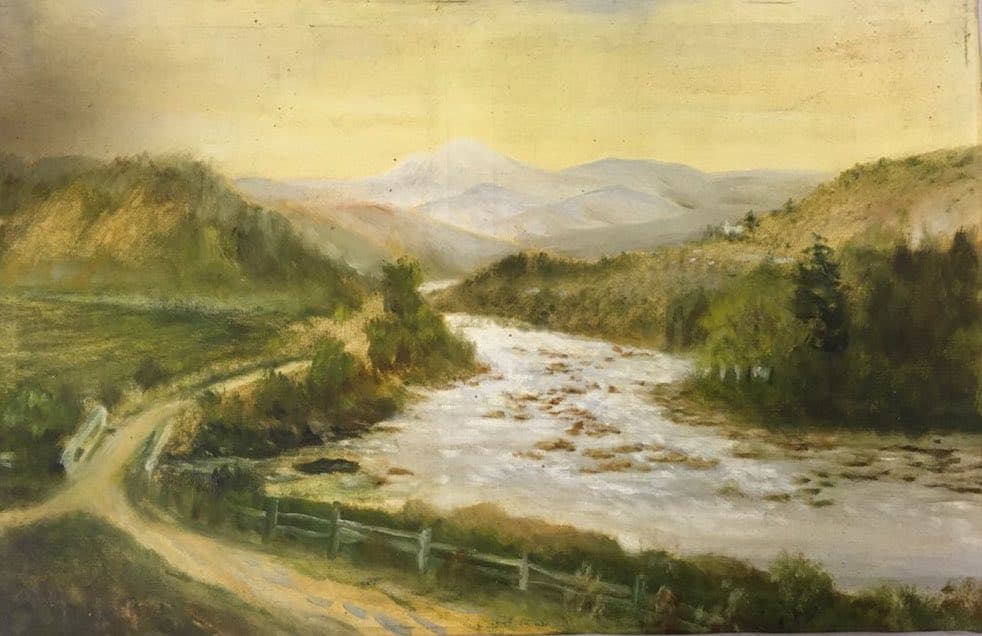
Clintonville’s natural beauty has inspired artists to interpret memories visually! One example from the Anderson Falls collection is this unsigned oil painting depicting the Ausable River at Clintonville in the late 1800s.
Anderson Falls Heritage Society has recorded an in-depth 1990 interview with Levi White about Arnold Hill. This fascinating account can be viewed by appointment or during regular museum hours.
An early map (ca. 1828-1839) of the Village of Clintonville records High Street, Main Street (part of the Port Kent-Hopkinton Turnpike and now Rt. 9N), River Street (now Lower Road), and Furnace Street on the north side of the river and the Jay Road on the south side.
Did you ever walk along the streets and sidewalks in Clintonville to Elliotts Store and Post office? Did you ever use the telephone booth? Did you or a relative ever have a dental appointment with “Doc” William Thwaits? Do you remember Ginett’s store? Did you ever visit the bookmobile? Did you stop and visit with Horatio Smith at his antique shop? Did you get your car repaired at Ashley Stranahans repair shop?
So many facets of Clintonville through the years! What are your special memories of Clintonville?
Day 5 – Clintonville Day!
Drumroll please– BIG NEWS!!
CIVIL ORGANIZATION VILLAGE INCORPORATION!
Culminating our week is a special red-letter day: It’s CLINTONVILLE DAY. April 11, 2025, has been declared Clintonville Day in the Towns of Ausable and Chesterfield by a unanimous joint resolution of the Town Boards!
The Village of Clintonville was incorporated by an act of the New York State Legislature on April 11, 1825. This predates the incorporation of the Village of Keeseville by over fifty years and attests to the relative size of the communities.
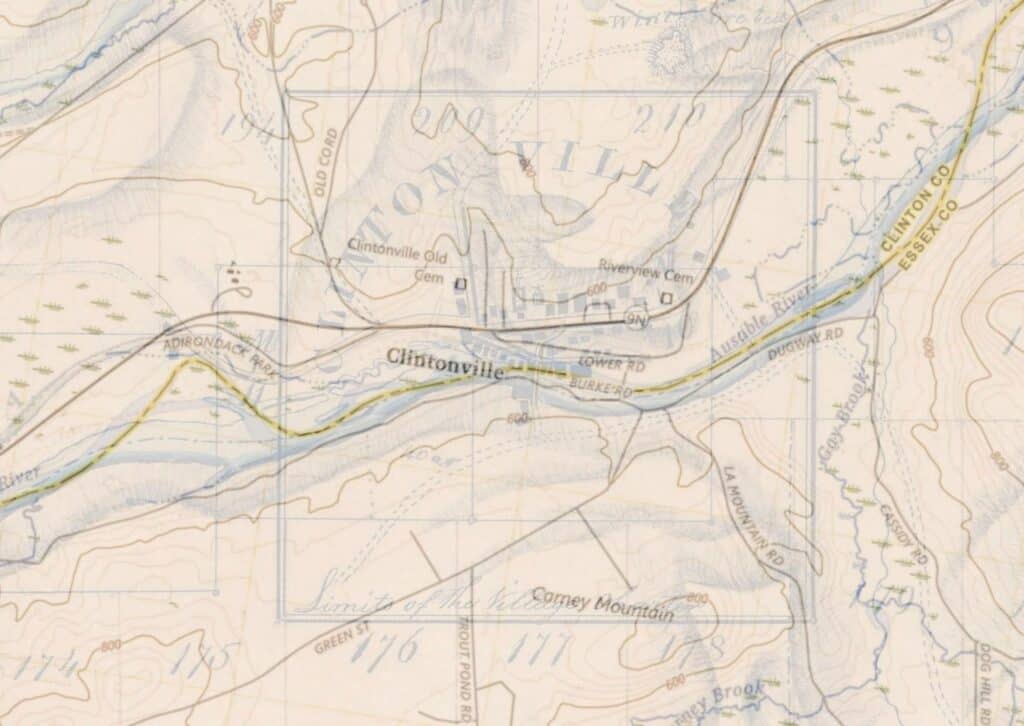
The special map [courtesy R. Prescott] shown here overlays part of an 1827 map by surveyor Frost outlining the limits of the Village Charter for Clintonville on a present day map.
The Village encompassed 1.56 square miles centered on the furnace of the Peru Iron & Steel Company. The yellow road is the route of the Port Kent to Hopkinton Turnpike.
The Village of Clintonville was empowered to hold elections, make laws, levy taxes and fines, establish streets and weights and measures, regulate retail shops, slaughter houses, and the sale of ardent spirits, restrain swine, geese, and cattle, and suppress “disorderly houses and houses of ill fame.” Clearly Clintonville was a hub of commercial activity!
The Legislature amended the incorporation act in 1827 to authorize the Village of Clintonville to appoint up to thirty firemen (with their consent) to “take charge of the engines and other apparatus for the extinguishing of fires.” The firemen were exempt from jury duty and military service, except in cases of insurrection, invasion or imminent danger.
The boundaries of the Village of Clintonville were extended 100 rods in each direction by the NYS Legislature on April 11, 1844, increasing the Village area to 2.43 square miles. As late as 1897 Clintonville remained a functioning village but at some later undetermined point its status as a village was dissolved.
Thanks to Supervisor Clayton Barber, Supervisor Tim Bresett, the Town of Chesterfield Board, and the Town of Ausable Board for their support of Clintonville Day.
The highway speed limit in Clintonville is 40 mph but we suggest slowing down today as you drive through and honk your horn in tribute of the 200th anniversary of the incorporation of the Village of Clintonville.
Cheers to Clintonville!
